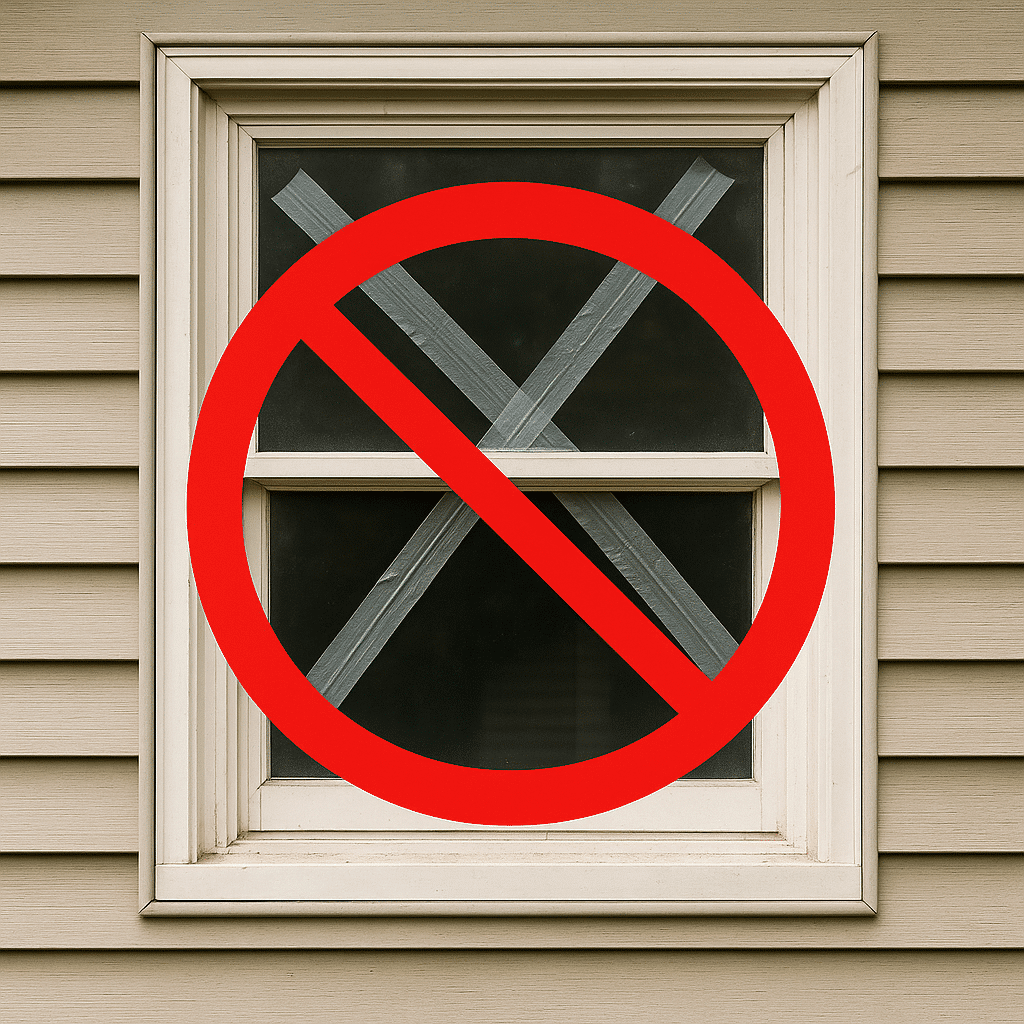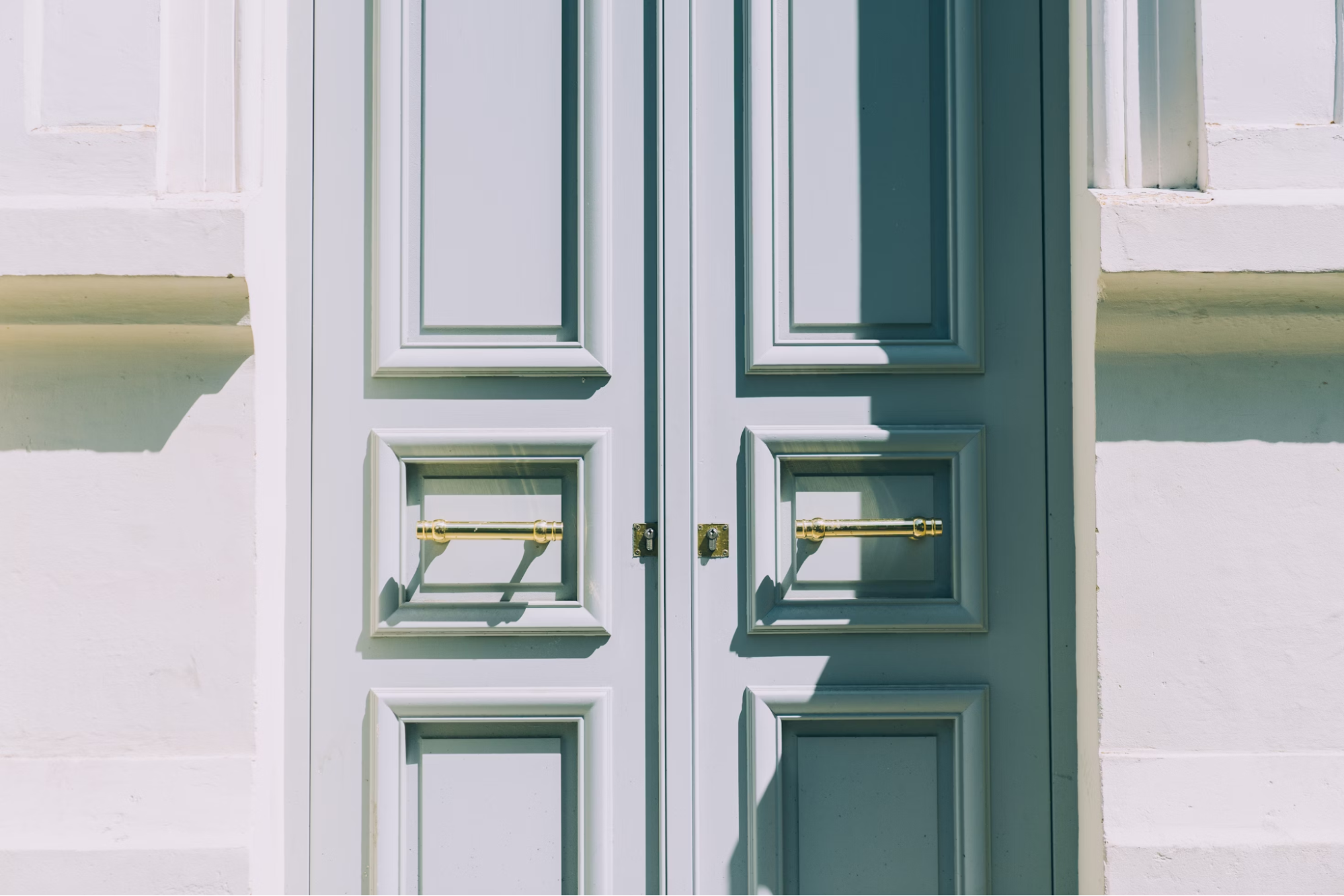
What are French doors? It’s a question we hear quite often, and after years of helping homeowners update their windows, doors, and more, we’re happy to explain.
Whether you’re planning a remodel or just curious, we’ll walk you through the basics and benefits. For more insights, browse our articles or connect with one of our experts directly.
What Is a French Door?
French doors, sometimes referred to as French windows, are simply a set of two doors, usually hinged, that swing open from the center. What really sets them apart is their extensive use of glass. Most of the door’s surface is made up of individual glass panes or a single large pane framed by wood, fiberglass, or other sturdy materials. The result is a door that connects two spaces and invites natural light to flow freely between them.
Other things that set these apart are that they work in pairs, opening wide to create a much larger passage than your typical single door, perfect for bringing in more fresh air. Compared to sliding glass doors, French doors offer a more classic architectural look. Plus, you’ll have the option of opening one side or both. And unlike solid interior doors, which block light and limit visibility, these create a sense of openness, even when closed.
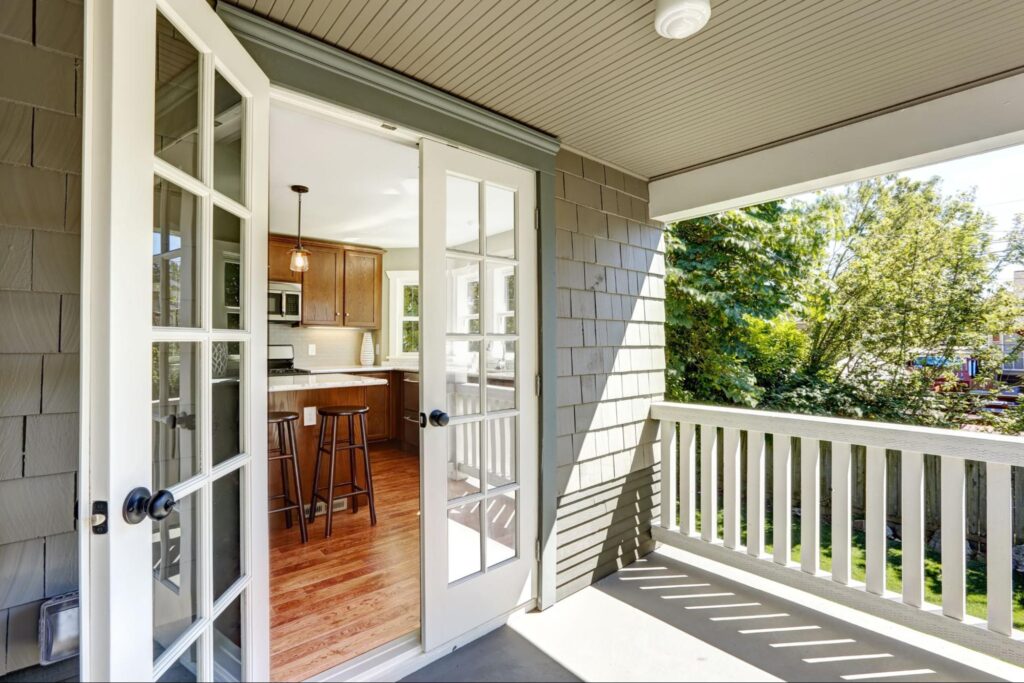
History and Evolution of the French Door
Traditional French doors have been brightening up homes for hundreds of years, and of course their story starts in France. These doors debuted back in the 17th century, right around the time the Renaissance influenced everything from art and architecture to how homes were designed. French architects designed these doors to offer more natural light, symmetry, and an open feel rather than boxed in.
Over time, their look evolved, but the core concepts remained the same. You’ll still find glass-heavy panels framed by wood or other materials that open wide to let in light, air, and a clear view.
You’ll find modern French doors in just about every style of home, from classic colonials to modern builds. And thanks to improvements in energy efficiency, weatherproofing, and customization, they’ve gone from strictly decorative to fully functional, blending beauty and practicality.
Benefits of French Doors
These versatile doors bring a whole list of perks to the table. Let’s start with some reasons why homeowners choose French doors:
- Natural light: Mostly made of glass frames, these doors act almost like floor-to-ceiling windows, flooding rooms with bright light and a welcoming feel.
- Easy indoor-outdoor flow: French patio doors that open to a deck or garden make moving between inside and outside seamless.
- Flexibility functionality: Want a little airflow? Crack one door open. Need a wide opening to move furniture or get a stronger breeze? Open both.
- Timeless style: They work with almost every architectural style, blending form and function without clashing with your existing design.
- Increased home value: They’re a sought-after feature that can improve curb appeal and interior charm, potentially boosting your home’s value.
That’s not to say these doors are perfect for every home. While they have plenty of strengths, here are a few downsides to consider before committing:
- Space needs: Since they swing open, either out or in, it may be tricky in tighter spots to get enough clearance to let them function fully. Plus, you need double the space of a traditional door for French door installation.
- Energy efficiency: Older or lower-quality French doors may lose some insulation compared to solid doors.
- Maintenance: With all those glass panels comes extra cleaning, especially if you’re using them to access outdoor spaces where dust and fingerprints pile up faster.
- Security considerations: While modern locks and reinforced glass help, all that glass adds a larger breakable surface than a standard door. Plus, it may be harder to protect such a large surface in extreme weather conditions.
- Cost factor: Depending on the materials, size, and customization you want, these entryways can cost more upfront than simpler options.
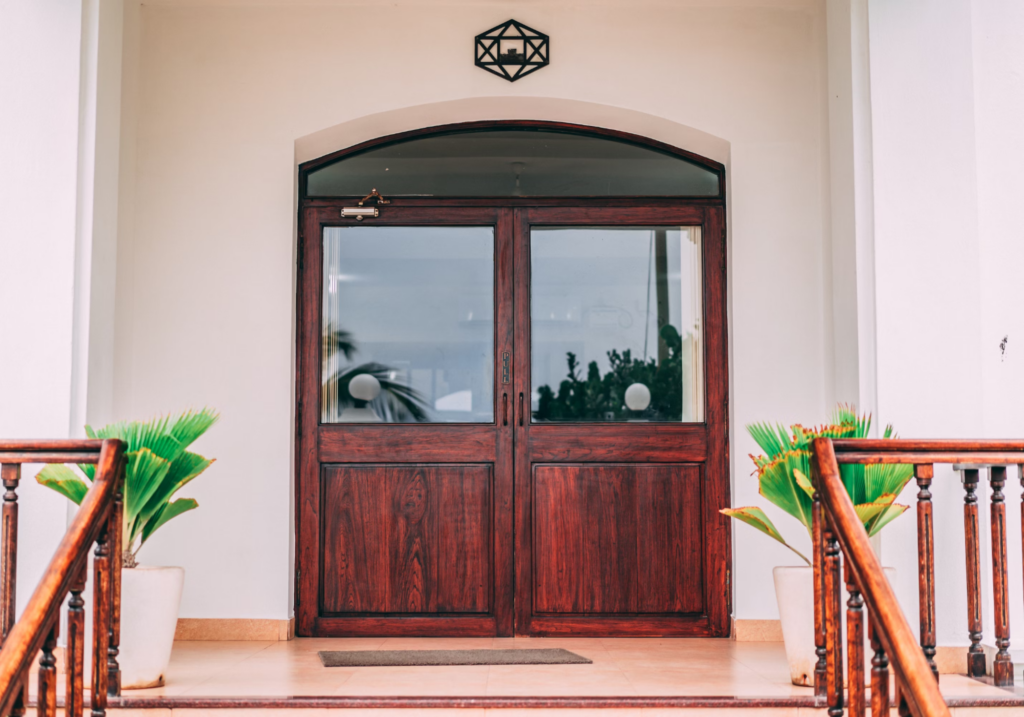
Types and Styles
French doors might all share the same basic idea, but that doesn’t mean they all look or function the same way. There are many options out there, with styles matching your home’s personality and personal taste.
Hinged French Doors
This is the definition of traditional French doors: two doors hinged on either side, meet in the middle, and swing open from the center. They’re popular for patios, garden doors, or even interior dividers between living spaces.
Sliding French Doors
Love the look of French doors but tight on space? Sliding versions bring the same glass-forward style, but instead of swinging open, they glide along a track, taking up less space.
Interior French Doors
French doors work beautifully in interior spaces, whether separating a dining room from a living room or creating a light-filled home office. These doors offer flexibility without completely closing off your space. Add French door shades if you want a little extra privacy without sacrificing the open, airy feel.
Exterior French Doors
When you want to blur the line between your indoor and outdoor spaces, exterior doors are the way to go. These connect living rooms to patios, kitchens to backyards, and bedrooms to balconies, combining function, beauty, and gorgeous natural light.
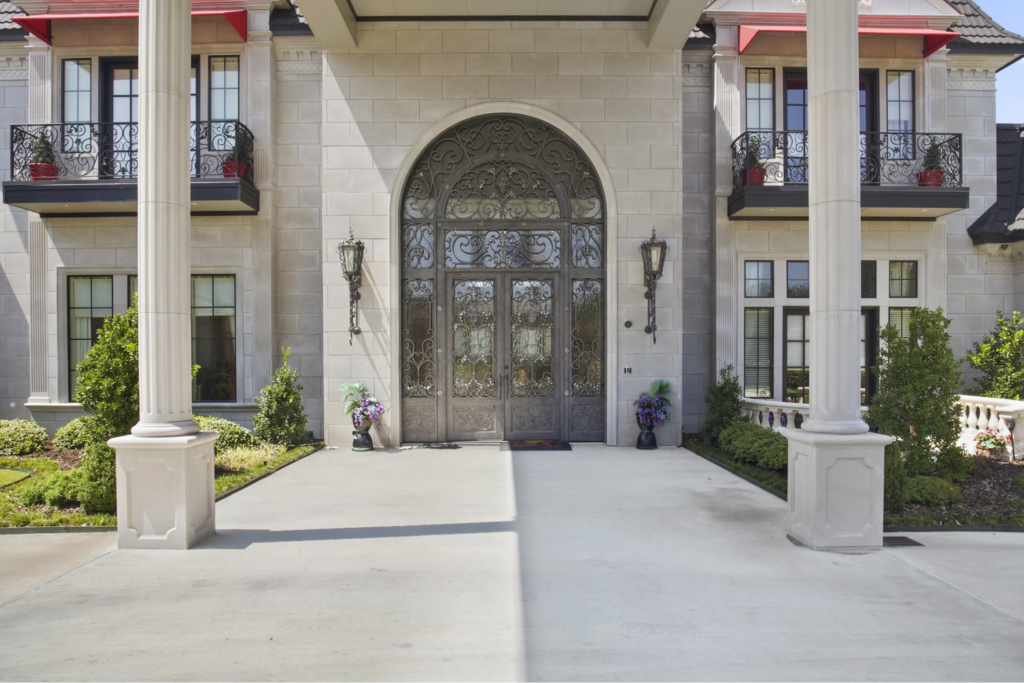
Sizing and Measuring French Doors
If you’re planning for your home’s French door installation, getting the right size is key. Luckily, standard French door sizes cover a wide enough range to fit most homes.
Standard French Door Sizes and Common Variations
There's some flexibility for standard French door sizes, but they usually follow familiar patterns. Most sets of two range from 60 to 72 inches wide, though you’ll sometimes see narrower pairs around 48 inches or wider setups pushing 96 inches. Height-wise, the typical range runs from 80 to 96 inches, with 80 inches (the same as most interior doors) the most common.
Of course, custom French door sizes are always an option if your space doesn’t fit neatly into those measurements. Older homes or unique renovations often call for something a little more tailored.
Step-by-Step Guide to Measuring French Doors
Measuring a space for French doors isn’t complicated, but it does require precision to get it to open and seal properly. Here's a simple guide to measuring French doors the right way:
- Measure the width: Measuring French doors’ opening width is your first step. This is the full space from stud to stud if you’re working with a new construction, or from one interior edge of the door frame to the other for replacements. Be sure to measure at the top, middle, and bottom since walls aren’t always perfectly square.
- Measure the height: Measure from the floor to the top of the opening. Again, check both sides and the center to account for any settling or unevenness.
- Check the depth: You’ll want to check this, especially if you’re upgrading from thinner doors to something more substantial. Measure the depth of the wall where the doors will sit to make sure your frame won’t stick out awkwardly or sit too shallow.
- Account for trim and swing clearance: Outside of measuring French doors, you’ll want to make sure there’s enough space for the door to swing inside or outside.
- Double-check and write down: The old handyman's saying may be cliché, but "measure twice, cut once"—or in this case, "order once"—still holds true. Getting the numbers right upfront makes installation smoother and helps avoid costly custom adjustments later on.
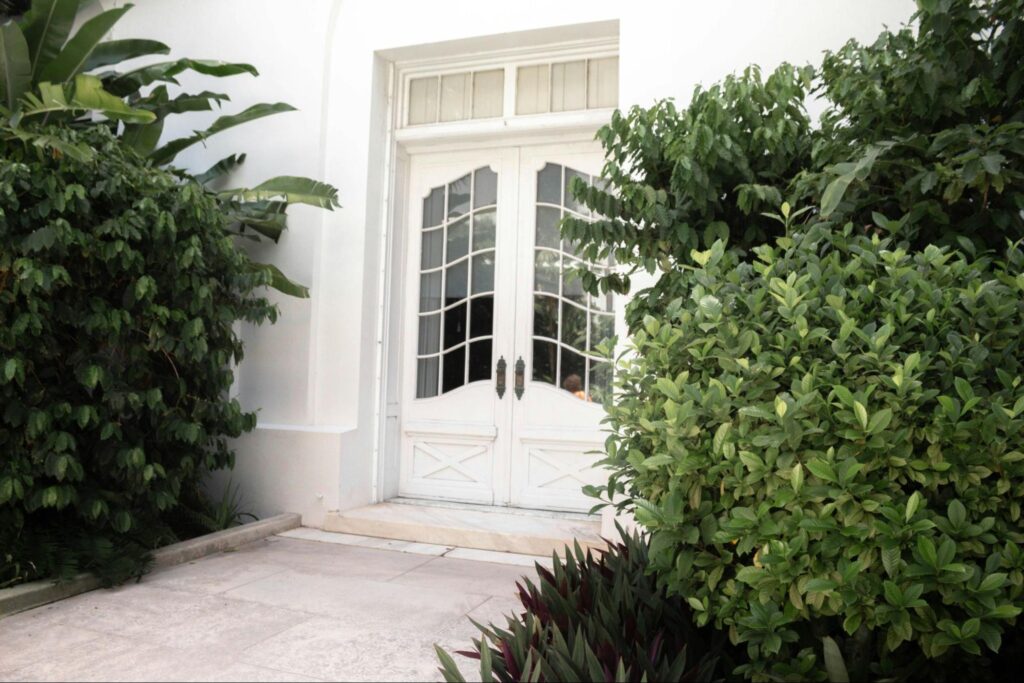
Best Window Treatments
One of the biggest perks of French doors — all that natural light pouring in — can also pose a challenge when you’re trying to strike the right balance between privacy and insulation. The right window treatments can make all the difference. And with so many options, you won’t have to sacrifice style to get the functionality you need.
Popular Window Treatment Options
French doors don’t play by the same rules as standard windows, so it helps to know what treatments work best for their unique design. If you’re wondering what are the best shades for French doors, here are some favorites that pair beautifully:
- Cellular shades: These lightweight, honeycomb-style French door shades offer great insulation, helping regulate temperature while still allowing soft light to filter into the room. They mount directly to the door frame, moving with the door instead of hanging separately.
- Roller shades: Simple, streamlined, and available in endless colors and textures, roller French door shades are a versatile option. You can go sheer to maintain the view, blackout for full privacy, or somewhere in between.
- Drapery panels: Full-length curtains framing your entryway can add a layer of softness and elegance. Just keep in mind that you have to pull them aside for full access.
- Roman shades: These fabric French door shades combine the softness of curtains with the structure of a shade. When lowered, they hang flat, covering the glass completely. Instead of rolling them up like a roller shade, they fold neatly into horizontal pleats as you raise them, almost like stacking gentle fabric layers at the top of the door.
- Blinds: While not as common, slim-profile blinds (wood, faux wood, or aluminum) can work on French doors.
French Door Installation and Maintenance Tips
French door installation requires precision. The doors need to align perfectly so they meet evenly in the center. Your rough opening exists for replacements, but new installations require careful framing, especially for wider exterior French doors. Level floors, proper timing, and good seals are key to smooth operation and optimal energy efficiency.
Once installed, regular care keeps them looking great and working for years. Clean the glass regularly, check weatherstripping seasonally, and lubricate hinges to avoid squeaks. If you’ve added French door shades, make sure they won’t snag when opening or closing.
Conclusion
French doors are a perfect blend of form and function. They bring in natural light, open up your space, and add timeless character to your home. With so many styles and treatments, there’s no shortage of ways to find the perfect French door for your home’s unique look and needs.
If you’re still unsure which type of door fits your style, space, and budget, get in touch with our experts. We’re always happy to walk you through the options and help you find the perfect fit for your home.
Frequently Asked Questions
Why do they call it a French door?
The name comes straight from France. Architects of the 17th century who loved symmetry, glass, and light created these elegant entryways to brighten interiors and connect indoor and outdoor spaces effortlessly
What is the difference between a double door and a French door?
While both have two door panels, French doors are all about glass to let in light and offer better views. Standard double doors are usually solid or have small windows, more focused on entry and security.
Which is cheaper: French doors or sliding doors?
Sliding doors are usually much cheaper because they’re simpler to manufacture and install. French door installation can be pricier due to the detailed framing, hinges, and extra sealing work to keep everything aligned and weather-proof.
What is the standard size of a double door?
For most homes, a standard double door runs 72 inches wide and 80 inches tall. However, custom sizes are out there if your space doesn’t fit the usual mold.
What is the smallest width of a French door?
The narrowest sets of French doors typically start around 48 inches wide for the pair. Smaller openings could work with custom single French doors, but you’d lose that classic double-door look.
What are the disadvantages of French doors?
French doors need space to swing open and require regular weather-proofing. Plus, all that glass means less insulation and more cleaning compared to solid doors.
70% off Installation
18 months no interest no payments



